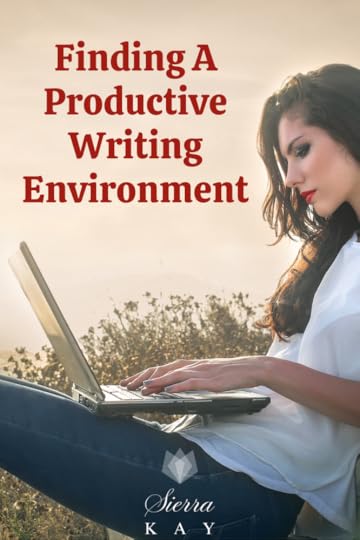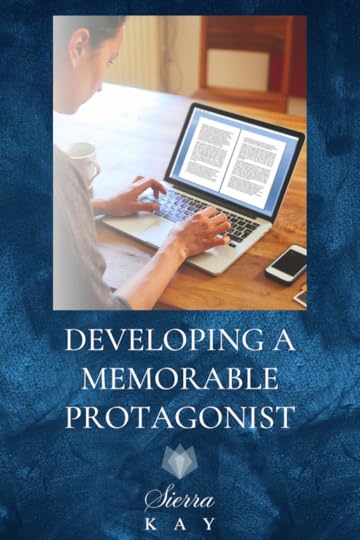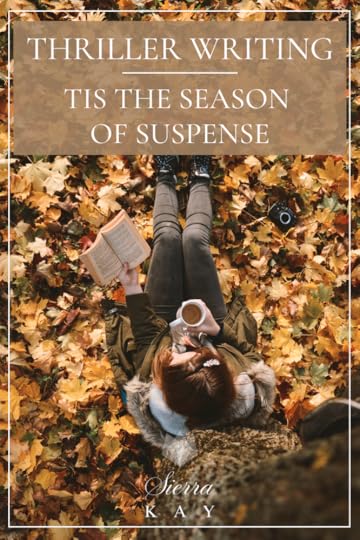Sierra Kay's Blog, page 2
June 1, 2024
Navigating the Path to Success: Working with a Book Coach
It’s 2024 and the online space has opened up a world of possibilities for creatives. Sharing your work with the world has become more accessible, but turning that world of possibility into an actual opportunity can be tricky when you don’t know the tricks of the trade.
Many writers, experts, and entrepreneurs opt to incorporate books as accessories to their platforms, with some leveraging a book to propel themselves towards their true calling.
Writing a book is an excellent way to share your story, knowledge, experience or opinions with the world. Whether it’s fiction, non-fiction, memoir or workbook, a book can give you credibility, status and help spread your message far and wide. It can also be an additional stream of revenue.

Choosing to write a book can be a highly fulfilling pursuit. However, it can also feel quite daunting. Can you relate?
Have you ever felt the urge to write, clear space in your schedule, and sit down only to stare at a blank screen with a dumbfounded look? You’ll never write your blockbuster if the writer’s block is holding you back.
Maybe you are on your way. Perhaps you have an outline, but you need help meeting deadlines. Then there’s the publishing industry. What in the world do you do after your book is finished? How do you get your material into the marketplace?
If any of this feels familiar you may be on course to hiring a book coach.
Best-selling author, publisher and book coach Sierra Kay says that a book coach is someone who enters your project objectively and creates a path forward.
“Writing can be a solitary endeavor and that’s why some people struggle with it. A book coach is like a creativity coach and project manager coming together. You have to have a timeline and a clear direction and that’s what I help provide,” Kay said.
As someone who has written and published six books and worked in the corporate arena, Kay knows how to balance creativity and she knows the publishing industry well. She says a book coach needs to be confident and competent in executing through processes. "I know how to get the job done."
A book coach can help you move the needle forward in an organized, timely manner.
“I know what it is to write, but I also know what it is to look at a blank screen and get past it,” Kay said.
In addition to keeping you on track in your writing endeavor, she also knows the publishing industry and can help you maneuver through it. A book coach helps you bust through the hurdles and get to the finish line.
Effective book coaches are process driven. Most book coaches will start with a short discovery call to see where you are in your process and if you are a good fit. As for Kay, she has an 8-Step framework that empowers authors to complete their book in as little as 90 days.
YES! As Kay said, there is always room for process improvement. She works with both nonfiction and fiction authors as well as published and debut authors.
No two book coaches are completely alike. Sierra Kay will not write your book for you. She is not currently a ghostwriter. “If you hire me as a book coach, I will coach you through the process."
This varies from coach to coach. “My framework is for three months, but it really depends on the individual. There are many ways to do this,” Kay said. “It really depends on the writer and if she is committed to the goal of getting her book complete.”
The fact that you’re reading this article might be a good sign. You’re considering help for your project and are looking for a professional to help you reach your goals. You might be having trouble getting past the writer’s block, or maybe you have no idea what comes after the first draft and how to enter the publishing arena. Maybe you need help staying focused and meeting deadlines.
If you are ready to go to the next level, are seeking feedback and motivation a book coach could be a benefit to you.
The support of a good book coach can make all the difference.
Are you ready to unlock your full potential as an author? Look no further than our personalized book coaching services.
Schedule a 20-minute introductory meeting and let's discuss how our book coaching services can help you achieve your literary goals. Don't miss out on this opportunity to unlock your true writing potential.
LEARN MORE ABOUT SIERRA KAY BOOK OFFERINGS.

Pin it to save for later!
Follow Sierra Kay on Pinterest.
May 1, 2024
How to Make Time for Writing in Your Busy Schedule
There are a lot of boons to being an author in the modern age: self, hybrid and traditional publishing has broadened the playing field; social media and email newsletters have taken marketing to a whole new level; and the use of SEO, keyword, hashtag and analytic research has made finding your target audience easier.
The list of benefits to being a modern author can really can go on and on. However, authors still experience challenges and a big one that continues to come up is finding time to write.
If so, keep reading for tips on how to find time to write.

There are fortunate authors that are able to write for a living, are retired or have all the free time they need in order to write. How blessed they are! However, many of us are still struggling to fit writing time in between family life, work, commutes, and all the responsibilities that come with life.
Time management comes easy to some, but is an acquired skill for others. Maybe you’ve heard that we all have the same 24 hours in a day. This is true. How we manage that time and what we fill it with is the key to finding time to write.
PRIORITY & WILLINGNESS
Making writing a priority - ie: a non-negotiable task - and being willing to write with the time that is found is a foundation to finding time to write.
Exercise: You've made time to read this post, now perhaps you can take some time to record your typical daily schedule without judgment or adjustment. Record everything from that ten minutes you spend scrolling to the time in the shower, driving etc.
You may know exactly how you are spending your time or need to observe it for a day or two to fully recognize what is truly important, how much leisure time you have and what you might be wasting your time doing.
Once the recording is complete, zoom out. Analyze how you are spending your time, again no judgment. Using a set of highlighters, delineate categories into:
Must do.
Want to do.
Didn’t realize what I was doing.
Why am I even doing this?
Now answer these questions:
What are the must do tasks? The most important things?
What activities are NOT on the list that you wish were?
What activities ARE on your list that you wish you could make MORE time for?
If not, you may not yet consider it a priority. Changing your mindset about writing, and considering it one of the most important things you do, will help you find time.
Now, answer these questions:
What activities on your list are not quite as important or optional?
What activities were you doing unconsciously?
Would you be willing to change your habits and replace some of these time slots with writing? Willingness is key!
Now that you have seen how you are using your time, maybe you have seen blocks that can be filled with writing. Let’s say you realized that an hour in your morning was spent sorting through emails. Or maybe you spend your work breaks scrolling social media. Perhaps you noticed that in the evening you are spending more than an hour watching television.
In general, there is nothing wrong with any of these activities and downtime is important. However, would you be willing to trade some of that screen time for writing screen time?
Are you able to trade doing half an hour of scrolling and perhaps grocery shop every two weeks instead of every week? Add that time up and put it together!
ORGANIZED & PREPARED
Have you identified a slot of time that you could possibly trade out for writing? Great! Next let’s take a look at how you can establish new habits.
Maybe you’re a night owl and you spend those late hours binging YouTube videos or talking on the phone. Maybe you’re willing to trade at least one of those hours for writing. Are you ready to change that habit tonight? Answers these questions to move you forward:
How will you ease yourself into writing mode? Will a cup of tea, playlist or your favorite essential oil diffusing put you in the mood? Can you work better when the kids are in bed and the dishes done? When do you need to prepare these things? Make a plan!
Will you write on device or longhand? Do you have these items?
Have you told anyone who might command/demand your time or inadvertently distract you during your chosen writing time? Will it distract them? Sometimes, others take offense to their loved ones working this way in the same room where they are trying to unwind. However, sometimes they won’t care! You can write with your laptop on the couch while your family is watching the latest show on tv or playing a game. The key is to know yourself and your loved ones and how distractions affect your writing. Be respectful to your time, writing and loved ones.
On that note, where do you plan to write? Will the couch work? Many find having some privacy helps keep them focused. Do you have a desk? An office? A bedroom? A closet? Maybe it's a she-shed, the break room at work or your vehicle!
Do you have materials in your chosen location: laptop, computer, notes, pens, research materials, etc? Spending time searching for things takes time away from writing and is a distraction. The clock is ticking. Tapping keys is better than searching for the keys!
It may take a day or a week or more to get into the groove and create this new writing habit. Getting your space, mind and mood prepared for writing will make this transition easier and faster.
Organizing your materials so they are ready when you are {just like brushing your teeth or making your coffee} will help create muscle memory with your task. Writing will become a part of your daily routine instead of a random act of inspiration or something you just wish you could do if only you could find time!
So have you discovered where and when you can find time to write? Here are some bonus tips:
Wake up earlier and use that time to write.
Stay up later and use that time to write.
Trade-in some downtime activities: scrolling the internet, watching tv, etc.
Turn your waiting room or pickup line time into writing time.
Work breaks can be turned into writing time.
Trim other tasks. Are you spending a lot of time preparing dinner or putting on makeup or shopping? Cut back and put some of that time toward writing.
Outsource! Is there a task you can pay someone else to do in order to free up time to write?
Be a weekend warrior. Maybe you have all weekends to write in peace. Maybe it’s a full Saturday morning. Mark it on your calendar and take advantage of this time.
Declutter your home and digital space to open up mental and physical space. Unsubscribe from some emails, unfollow some social and streaming. Clean out a closet that could house a desk and a lamp for writing. Making space is just as important as making time.
Be intentional. Once you make writing time, use it wisely and be grateful for the time you have been given.
In conclusion, finding time to write can be daunting and seem impossible, but once we analyze how we are spending our time, we can often make some trades, clear some space and create a writing practice that isn’t rushed, respects our important tasks and people in our life, and most importantly brings value and produces good fruit.
Making a plan, organizing your materials and space as well as preparing your heart and mind will make your newfound writing time a habit you are excited about!
Prioritizing matters. Willingness is key. Preparation is essential.
Now go find time and write on writer!

Pin it to save for later!
Follow Sierra Kay on Pinterest.
Do you have a story on your heart you would like to turn into a book?
Whether you're struggling with motivation, seeking honest feedback, or feeling overwhelmed by the publishing industry, our proprietary 8-step framework is designed to help you complete a phenomenal book.
We're here to provide you with the expert guidance, motivation, and feedback you need to take your writing to the next level.
Ready To transform Your Writing Journey?
Schedule a 20-minute introductory meeting and let's discuss how our book coaching services can help you achieve your literary goals. Don't miss out on this opportunity to unlock your true writing potential.
Click the hashtag for more #writingtips
Follow Sierra Kay down the modern fairy tale rabbit hole by visiting her book library here.
April 1, 2024
Self-Care For Authors: Strategies for Balancing Creativity and Well-Being
Self-care.
It’s a phrase that gets tossed around a lot. It may conjure images of relaxing in fuzzy slippers and eating bon bons, but it’s way more than that. Self-care is maintenance for our physical, emotional, spiritual and mental well-being.
We are each responsible for our own self-care… hence the “self.” That doesn’t mean relationships don’t play a role in these areas of our lives, but it also doesn’t mean we should leave the duty solely to others. We must take care of ourselves.
And authors are no different.

Many authors are working day jobs while filling their downtime with writing, publishing and marketing endeavors. Or, if you’re a full time author, you're most likely rolling full steam ahead to make a go at the publishing life. In either case, you might find yourself burning the candle at both ends, and that can quickly lead to burnout.
The self-care solution?
A proactive approach to self-care is the best way to prevent burnout.
"Build self-care into your daily routine," says Sierra Kay, author of six thriller novels. "Everyone's writing routine is different, so your self-care will look different too."
This can be a morning devotional, making lunch time sacred, taking a walk after work or making time for friendships. Building self-care into your day, gives you the well-being and fuel to focus when it comes time for writing.
Even with our best laid plans, writers are susceptible to burnout. How can we read the signs that burnout is approaching?
"Listen to your body," Sierra Kay says. "It's easy to get caught up in the groove of the story. Your mind may be willing to keep writing, but your body will let you know if you've been sitting too long." There comes a time when your body reaches its limit, no matter how ergonomic your chair is designed.
The self-care solution?
Step away from the screen & Into Life
Whether it be for thirty-seconds or 30-days, stepping away from your screen and writing can make a huge difference in your physical and mental state. Take that time away to self-care.
"Stepping away from the screen is important. As an author I write better when I am experiencing life. Go outside, do things, be with friends. It may feel like you're not being productive unless you're in front of the computer, but time away can actually make you more productive."
Taking care of ourselves is not only good for our well-being, but also our creativity. If you've found yourself frustrated with a blank screen, it may be time for a mind and body refresh.
"If you don't self-care you're going to have a struggle; creative or physical. It can manifest in many ways," Kay said. And this goes for anyone, not just authors.
The self-care solution?
Space.
"Giving my mind space is an act of self-care," Kay said.
This can come in many forms such as going to the gym, taking a walk, a bubble bath or gardening.
"Talking to someone who you know is going to make you laugh is self-care," Kay said. "Laughter is the best medicine."
Putting yourself in a more relaxed space will not only refresh you personally, but it will also allow creativity a place to grow.
"Many times the answer I seek comes when I am doing something else," Kay said.
Take note of this the next time you are in the shower, on the treadmill, laughing with your friends or enjoying a delicious meal. Allow yourself to relax. Allow solutions, answers and creativity to blossom in the blank space.
Your writing no longer lights you up.
Your creativity seems lackluster.
You resent having to write instead of looking forward to it.
Your body is tense.
Step away from the screen; no matter how long.
Exercise. It's hard to get started and easy to stop. Find a good routine.
Take a bath. Soaking in water can calm your nerves and spark creativity.
Drink more water. Staying adequately hydrated is important.
Take a walk. Movement works the body and stirs the spirit.
Get fresh air. Open a window.
Engage in a hobby outside of writing.
Spend time with people! Friends are a blessing.
Find a way to let and go. Laughter is the best medicine!
What Sierra Kay Take Away are you ready to implement? Comment below, we'd love to know!
Click the hashtag for more #writingtips

Pin it to save for later!
Follow Sierra Kay on Pinterest.

Follow Sierra Kay down the modern fairy tale rabbit hole by visiting her book library here.
March 1, 2024
How to Use Your Notebook To Generate Ideas and Boost Creativity

A writer can have many tools in her toolbox: computer, dictionary, word processing software, a window and a comfy chair, but to many wordsmiths, nothing quite compares to the usefulness of a notebook.
The notebook is a depository, where many of your captured ideas and inspiration live until you're ready to use them. Thoughts are fleeting, memories are fickle, but notebooks stand the test of time and distance.
The utilitarian notebook is portable, able to travel with you to most places you might venture. For best-selling author Sierra Kay, it’s something she doesn’t leave home without.
“I have at least one on me all the time,” Kay said. “I’m a writer, so I never think it’s odd for me to pull out a notebook.”
Maybe you’re a writer too and you also carry a notebook in your car, purse or jacket pocket.
Capturing obvious nuggets inspiration is one sure-fire way to use the notebook, but how else can an author harness the power of the paper and jump start a creative lull?
Here are four ways you can use your notebook to generate ideas and unleash creativity: Sorting. One way to generate ideas is to reserve pages for sorting specific levels of inspiration. For instance: Words, Character Names, Adjectives, Adverbs, Smells, Scenery, or Titles. This is next level organization, but could be a treasure chest when it comes to finding just the right word for the paragraph that won't write itself. Perspective. Most of us spend a great deal of time on screens and pattering away at keyboards, but there is something to be said for seeing words lined up on a piece of paper. “Because I write poetry too, seeing how the words associate with each other on a line of paper matters,” Kay said. Resource. Don’t forget to actually resource your notebook when you are writing. Not only will it help you remember, but any given passage can also inspire a whole new thought. “Sometimes when I look at a blank screen nothing happens. I can look at my notebook to help generate ideas,” Kay said. The key is remembering to have it handy when you are actually sitting down to write. Active Observer. Intentionally using your notebook as a landing page for active observing can be a game changer. This is one of our favorite ways to use the notebook for idea generating and busting through writer's block.Try this exercise out for size!Grab your notebook and your favorite pen. Stay where you are, or move to different locations. You can do this literally anywhere.Try listening to conversations, people watching, tasting a meal, taking a hike, watching the rain fall, reading a menu, and the list goes on, the sky is the limit.The name of the game is to observe and record in your notebook what you can pick up with your senses. Train your brain to pay attention to the details, names, movements, smells and shapes. This exercise can provide a missing piece to your story, or can inspire a whole new book! Are you uninspired? Grab your notebook and try this exercise!Need a new notebook? Sierra Kay offers an inspiring collection to hold all your ideas.

Did this blog post inspire you to use your notebook as a creativity booster? Comment below, we'd love to know!
Click the hashtag for more #writingtips
Follow Sierra Kay down the modern fairy tale rabbit hole by visiting her book library here.

Pin it to save for later!
Follow Sierra Kay on Pinterest.
February 1, 2024
Finding A Productive Writing Environment
Writing is a very personal activity. It’s almost always a solitary endeavor and requires - at the very least - focus. When writing, authors hope to get into the zone and allow themselves to be transported into their story. It’s the place where time and space disappear and creativity takes over. It’s the sweet spot that author’s love to find themselves.
However, getting into that zone is easier said than done. It can even be a source of discouragement or even writer’s block.
So how can an author cultivate deep writing focus?One way is to create an appropriate environment and atmosphere with which to work. Does it really matter?
“Absolutely, yes it matters,” says author Sierra Kay. “It sets the stage for success.”
Today we’ll take a deep dive into the why, the what and the where.

ENVIRONMENT
Environment refers to the external factors in the writer’s surroundings. Such as the room and objects in the room, or nature and the things within awareness like water or a tree.
ATMOSPHERE
Atmosphere refers to the mood or emotional tone within the environment. Think of the five senses. Lighting, temperature, scent, sound and taste.
Consider these examples. Which sound more appealing to your writing practice?
A library that is typically hushed and subdued with books and computers. People are milling about, whispers are prevalant. A train ride with the sound of rails, the squealing of brakes or maybe passengers speaking to one another. Out the window you watch the countryside fly by, each home or town you pass has history and secrets. The scenery captures your imagination. You're on the couch with a crackling fireplace, a cup of hot tea on the end table, a lap blanket cradling your laptop and a big picture window with snow falling. You have nowhere to be and nothing else to do. What feelings would this atmosphere invoke? Would you be able to get into the zone? Coziness and safety are a couple atmospheric elements that could put you in the zone. Here’s another scenario: Picture yourself on a solo camping trip in a drafty cabin, with an earthy smell, the wind whipping and random animal footsteps keeping you on edge. This atmosphere is the opposite of cozy and safe, but could inspire a whopper of a thriller novel. Perhaps you are simply in your home office. It’s the end of the day and all your tasks are put to bed. You have two hours to write. You turn on a small desk lamp, turn up some Dianna Krall jazz, light your favorite candle, close the office door and sink into your favorite chair to write.These are just a few scenarios that writers might find themselves, which ones sounded ideal? Which ones did you not like at all? What does your current writing atmosphere feel like? If you’re struggling to write or to get into the zone, it might be time to evaluate your environment and make some adjustments.
“Sometimes I prefer the corner of a coffee shop. It feels like a productive space and I feel the drive to be productive as well,” Kay said. “There’s people around, but they aren’t necessarily talking to you.”
Of course the smell of coffee doesn’t hurt either.
“Temperature can play a part where you are too. If I’m in a coffee shop sitting near the door and it’s cold outside, that can get distracting.”
Perhaps you’ll find yourself in an atmosphere that is the catalyst for you to write. While Kay has found herself writing in coffee shops and beachfront getaways, they are certainly not the most unique places she’s written.
“I was recently at the Chicago Symphony Orchestra and was inspired to write a poem right in the middle of the concert,” Kay said. Now that's taking advantage of inspiration!
Have you ever written anywhere unique like this and captured creativity in the moment, letting atmosphere and environment be your guide? Comment below!
Here are some examples of some more prevalent writing environments:
A home office. A coffee shop. Your car. The park. A deck. A porch. The library. Your couch. A restaurant. A cabin in the woods. An AirBnB The kitchen table. Vacation. At work on a break.How many of those places sound like creative zones to you?
All that is really required to write is an idea and a way to get that idea out of your head, whether that be pen and paper or computer. However there are many things that can make the writing experience more pleasant, productive and comfortable.
Here are a few features to consider:
A window for “thinking.” Most authors would agree with this one! A desk. A door. Privacy can help so much. A comfortable chair. Lighting. Whether it be overhead lighting or lamps, lighting can make a huge difference in your ability to work productively. Being able to see is important as is the mood it sets. Music. The right melody can put you into focus. Having a playlist for your writing is also super inspiring and motivating. Headphones. Sometimes you just need to escape into your own world - the world of your book Notebooks. Pens and pencils. Climate control. Consider keeping a lap blanket, cardigan, a stocking cap or a fan for comfort. A ceiling fan is also helpful for climate and air circulation. Computer. Drink with a coaster. Snacks. A snack can ward off hunger pangs and keep you from leaving your work space. Clock. If you’re blessed, you’ll get in the zone and time will get away from you. A clock can help keep you within your writing boundaries. Scent. Candles, fresh flowers or essential oils. Scent can inspire, calm or energize. Nature. Houseplants, a water feature, vase of flowers, or even a rock to hold as you brainstorm your plot, nature provides a wonderful source of grounding. Books! Many writers find that being surrounded by books is a motivating and comforting environment. Research can be at your fingertips.If you are struggling with focused writing time, consider taking a look around your workspace. You may need to shake things up a bit. Maybe you need to add something or take something away. Maybe you need an office makeover. Maybe you just need to move to a new location for a day or two or indefinitely.
“If inspiration isn’t striking at home, I can always go somewhere else,” Kay said.
Sierra Kay Takeaways
Analyze. Take a look at your current writing space. What elements are conducive to writing? Which ones distract you from getting in the zone? Eliminate. If possible eliminate the distractions or the things that are preventing you from solid writing. Additions. What could you bring into your work space that would cultivate creativity? Create Atmosphere. What feeling are you trying to evoke? Add elements that move the senses and create mood for the topic of your book. Experiment. Don’t be afraid to step outside your comfort zone in order to get into the zone. Try writing in different locations. Try engaging the senses with different elements.Did this blog post inspire you to make a change in your writing process? Comment below, we'd love to know!

Click the hashtag for more #writingtips
Follow Sierra Kay down the modern fairy tale rabbit hole by visiting her book library here.

Pin it to save for later!
Follow Sierra Kay on Pinterest.
January 1, 2024
Thrilling Readers With Symbolism & Metaphor
Using symbolism and metaphor in thriller writing can help create a depth in the storyline that readers will love sinking their teeth into. Did you see what I did there?
Used appropriately and peppered throughout the story with skill, an author can create relatability, interest and thrill to an otherwise bland plot.
Symbolism and metaphor gives layers to a story. It creates a punch to emphasize and drive a point home., It brings the book to life through character, setting and plot. It invokes imagery and emotion from the reader, which helps get them invested in the story. It can educate and be the catalyst for something bigger., It deepens the mystery, thrill and suspense. And you can start using these literary devices today.
 Symbolism.
Symbolism. Symbolism is when authors use a symbol to represent something with a deeper ideal, something unreal or abstract. A few examples are images, patterns, inscriptions, designs or motifs. Such as a snowflake being the symbol of winter or the sun being the symbol of summer, a leaf for autumn and a raindrop for spring. These are universal symbols, but there are symbols that represent things unknown as well. You can even use a popular symbol and put your own spin on it, giving it meaning specific to your book and your character.
A good example of this in Sierra Kay’s ,,From Behind the Curtain is Dee’s mother’s shoe legacy. For one thing, the shoes parallel Dorothy’s ruby red slippers from the Wizard of Oz - an excellent example of symbolism in a fairytale retelling - but furthermore the shoes represent even more than Dorothy’s strength and way home.
Read this excerpt ,,From Behind the Curtain:
Dee walked over to her mom’s bedside and stumbled on a pair of shoes in the middle of the floor. “Damn it,” she whispered, before she could catch the words. “Nipsey must’ve left these here.” She placed the red pumps in a clear box near the closet filled with her mother’s shoe legacy.
Every pair had a story, a memory for her mom. She often liked to see them to remember.
Kay makes it clear to the reader that the shoes represent something more than the physical object. They symbolize and invoke memories and her mother's self-confidence.
“You know I wore these black ones when I took your aunt back to the airport,” her mom would say. “That’s how I learned beauty and pain went hand-in-hand. Girl, her plane was delayed and my dogs were barkin’, but I did get a lot of compliments.” Or, “I wore these when I left your father in Las Vegas,” she would say with a defiant gleam in her eyes. “I strutted out of there on my pink stilettos with my head held high. I got a lot of second looks that day.”
This paragraph doubles up on richness. In addition to the shoes symbolizing poise under pressure, Kay also uses the idiom of my dogs were barkin’ to refer to her feet within the shoes.
Metaphor.Authors use metaphor to compare one thing to another in their writing. It is not literally true.
Read this example from Sierra Kay's ,,In The Midst of Fire:
Chase walked to the bedroom window, which gave a view of the gentrified building across the street. This block was merely one mile from the lake that it made it worth it for the monied to move across the street. But, this particular housing project was so deeply rooted, its foundation may have hit the earth's core, making it too difficult to move its inhabitants anywhere.
The reader knows the project isn’t rooted literally to the core of the earth, but the metaphor helps us understand the depth of the root and how difficult it would be for anyone there to leave. The exaggerated comparison gives depth, in more ways than one.
Another example from this book is:
He did stick around Chicago for a while, but finally decided his life was haunted by too many ghosts.
The character is not being haunted by literal ghosts, but by people, places and things from his past. The comparison makes us understand why he left and in what way the past affected him.
So now it's your turn, writer. Here are four ways you can strengthen your symbolism and metaphor muscles and thrill readers.
Four ways you can add symbolism and metaphor to your thriller writing: Turn on your radar. As you go about your day and observe life taking its course, turn on your radar and pay attention to symbols. Look deeper and try to understand what they stand for and why. In addition listen and watch for the usage of metaphor in conversation, music, written work and media. Take mental or physical notes. With your radar on, you’ll be able to recognize more and more, giving you an edge when you sit down to write. Get out your shovel. Dig deep, writer! Look at the current chapter you are writing. Where are the power points? What passages do you want to emphasize? What could use some metaphorical pizzazz? Once you pinpoint a few options, put on your thinking cap and compare them to something not literal. Build a mystery. Use symbolism and metaphor as a way of building the mystery. Many thriller readers enjoy the genre because they like the challenge of figuring out a mystery, and the adrenaline of the ride to the answer. As anxious as they are to know the ending, peeling off the layers of the metaphorical onion is just as enjoyable. They want to be engulfed by the mystery and know details. Symbolism and metaphor are a few ways to provide that. Thriller writers want to lead their audience somewhere, and they often use breadcrumbs along the way to do so. Take advantage of those clues and enrich them with symbolism that the reader must decode in order to move forward in the story. Research. Once you know just a few things about your story - maybe the character or the main setting - then start researching the details. Setting provides an enormous opportunity for using symbolism and metaphor. Every place has something special about it, maybe something esoteric, poignant or captivating. Capitalize on the symbols. Use metaphor to describe its idiosyncracies and nuance. You can research online or in-person. There are authors who take road trips to really get a feel for what they are writing about. And don’t forget that the library has historical materials that may not be available online. These details are a treasure to readers. Have fun with it!Now.,.. to start getting your radar tuned in, skim through this post again, and see if you can find all of the metaphors and symbolism used!

Click the hashtag for more #writingtips
Follow Sierra Kay down the modern fairy tale rabbit hole by visiting her book library ,,here.

Pin it to save for later!
Follow ,Sierra Kay on Pinterest.
December 1, 2023
Reshadowing or Foreshadowing
Foreshadowing is a tactic writers use to drop subtle hints of what’s to come in their story. It’s a method that works well, especially in thrillers, to help build tension and anticipation.
Foreshadowing is most often found toward the beginning of the book. It sets the tone for the story. Authors use location, symbolism, marked changes in weather or attitude, phrasing “that’s not good”, or settings to weave in their foreshadowing. Many authors, specifically thriller authors, find foreshadowing to be a useful tool in creating a deeply layered tale.

Foreshadowing can even be used in titles such as the Sierra Kay title: Sweet Whispers of the Devil. We all know nothing good can come from listening to that whispering voice. This is foreshadowing. We know there is going to be a nefarious character, what we don’t know is how the main character will handle it and or if she will be triumphant. We hope she is, and the story takes us on the ride to find out. The title pulls us in, knowing there is trouble ahead.
How to foreshadow:
Drop a breadcrumb.
Make it subtle.
Tie it all together.
There’s no doubt that foreshadowing is a great tool for authors.
Plotters use foreshadowing as they outline and write the beginning of their stories.
But what if you aren’t a plotter? What if you’re a pantser who doesn’t yet know where the story is going? What if you are letting the story unfold as you write, with no climax or definitive end in sight?
Can you still use foreshadowing?
Psychological thriller author and unapologetic pantser, Sierra Kay, does just this with a technique called Reshadowing.
Reshadowing is a method in which authors - particularly pantsers - work in foreshadowing aspects later when their story is written.
Kay, a master of fairy-tale retellings, says, “I go back and drop in bread crumbs and nuggets afterward. I build it in so that the ending I’ve written makes sense.”
Envision a painting if you will. If the artist was a pantser she would paint the whole painting first, not knowing exactly what the whole picture will look like. Once the painting is complete, she can turn it into an intricate puzzle, by backtracking and strategically leaving planting seeds, leaving bread crumbs and cutting the pieces to suit the big picture.
“You have to know your story well so you know where to put your foreshadowing,” Kay said.
Kay not only reshadows most of her stories, but she encourages any pantser unsure of where to start to try this method as well.
Your Sierra Kay Takeaways
What is Foreshadowing? Foreshadowing is when an author leaves hints about the developing plot.
Who is it for? Foreshadowing isn’t limited to plotters. Pantsers can foreshadow using other methods if they aren’t ready to leave the bread crumbs at the beginning of their writing process.
What is Reshadowing? Reshadowing is a foreshadowing method for pantsers. It involves writing the big picture story and then weaving in foreshadowing aspects after the fact.
Should Pantsers capitulate? Certainly not. Pantsers make their own rules and with reshadowing they can have their cake and eat it too.
Why use Reshadowing? Freedom. Not knowing certain aspects of a story can lead to writer’s block or analysis paralysis. With reshadowing, pantsers have the freedom to thicken their plot after the dish is made.
What Sierra Kay Takeaway are you ready to implement?

Click the hashtag for more #writingtips
Follow Sierra Kay down the modern fairy tale rabbit hole by visiting her book library here.

Pin it to save for later!
Follow Sierra Kay on Pinterest.
Reshadowing
Foreshadowing is a tactic writers use to drop subtle hints of what’s to come in their story. It’s a method that works well, especially in thrillers, to help build tension and anticipation.
Foreshadowing is most often found toward the beginning of the book. It sets the tone for the story. Authors use location, symbolism, marked changes in weather or attitude, phrasing “that’s not good”, or settings to weave in their foreshadowing. Many authors, specifically thriller authors, find foreshadowing to be a useful tool in creating a deeply layered tale.

Foreshadowing can even be used in titles such as the Sierra Kay title: ,Sweet Whispers of the Devil. We all know nothing good can come from listening to that whispering voice. This is foreshadowing. We know there is going to be a nefarious character, what we don’t know is how the main character will handle it and or if she will be triumphant. We hope she is, and the story takes us on the ride to find out. The title pulls us in, knowing there is trouble ahead.
How to foreshadow:
Drop a breadcrumb. Make it subtle. Tie it all together.There’s no doubt that foreshadowing is a great tool for authors.
Plotters use foreshadowing as they outline and write the beginning of their stories.
,,Foreshadowing helps a writer direct the plot from Point A to Point Z.But what if you aren’t a plotter? What if you’re a pantser who doesn’t yet know where the story is going? What if you are letting the story unfold as you write, with no climax or definitive end in sight?
Can you still use foreshadowing?
,OH YES! YES YOU CAN!Psychological thriller author and unapologetic pantser, Sierra Kay, does just this with a technique called Reshadowing.
Reshadowing is a method in which authors - particularly pantsers - work in foreshadowing aspects later when their story is written.
Kay, a master of fairy-tale retellings, says, “I go back and drop in bread crumbs and nuggets afterward. I build it in so that the ending I’ve written makes sense.”
Envision a painting if you will. If the artist was a pantser she would paint the whole painting first, not knowing exactly what the whole picture will look like. Once the painting is complete, she can turn it into an intricate puzzle, by backtracking and strategically leaving planting seeds, leaving bread crumbs and cutting the pieces to suit the big picture.
“You have to know your story well so you know where to put your foreshadowing,” Kay said.
Kay not only reshadows most of her stories, but she encourages any pantser unsure of where to start to try this method as well.
Your Sierra Kay Takeaways
What is Foreshadowing? Foreshadowing is when an author leaves hints about the developing plot. Who is it for? Foreshadowing isn’t limited to plotters. Pantsers can foreshadow using other methods if they aren’t ready to leave the bread crumbs at the beginning of their writing process. What is Reshadowing? Reshadowing is a foreshadowing method for pantsers. It involves writing the big picture story and then weaving in foreshadowing aspects after the fact. Should Pantsers capitulate? Certainly not. Pantsers make their own rules and with reshadowing they can have their cake and eat it too. Why use Reshadowing? Freedom. Not knowing certain aspects of a story can lead to writer’s block or analysis paralysis. With reshadowing, pantsers have the freedom to thicken their plot after the dish is made.What Sierra Kay Takeaway are you ready to implement?

Click the hashtag for more #writingtips
Follow Sierra Kay down the modern fairy tale rabbit hole by visiting her book library ,here.

Pin it to save for later!
Follow Sierra Kay on Pinterest.
November 1, 2023
Developing A Memorable Protagonist
A memorable protagonist can make all the difference in the success of your story and your career as an author. Character creation isn’t hard, you simply imagine a person and flesh it out with features and personality. But in order to develop a larger than life character, specifically a memorable protagonist who is the anchor of the story, we must go a few steps further down the rabbit hole. We must put on her proverbial shoes and see what makes her tick in order to develop her into a strong leading player... one your reader will remember.

Consider these points as you create your next protagonist:
TALK TO THEM
One of the great techniques that Sierra Kay uses when writing her thriller novels, is to sit the characters down in a chair and talk to them. Try it! Find out who your lead character is, and as you do so, weave this information into an extraordinary protagonist with a bio that is interesting, relatable and memorable. Make her worthy of the lead.
CREATE PHYSICAL ATTRIBUTES:
When developing your protagonist be careful not to fall into the trap of making her the most beautiful woman that ever lived. That’s been done and readers are not falling for it anymore. Plus, if it’s ever a film adaptation who the heck is going to fill that role?
A better way to develop their physical demeanor is to be realistic. Yes, she may be beautiful, but what makes her so? Is it her chocolate brown eyes that sparkle when she smiles? Is it her sharp cheekbones that clench when she’s thinking? Is it because her ponytail is always perky and bounces when she walks? What makes her beautiful to you and more so, what will the audience appreciate?
In addition, the reader needs to know what she looks like, and fairly early in the story so we can identify her in our mind and picture her acting out the story..
The sky really is the limit when developing the physical attributes of your protagonist. The key is to describe things that identify her, make them interesting and then down the road link those attributes to the story in some way. Bingo! A dynamic well-developed character.
,,Identify with description. ,,Make it interesting. ,,Link it later in the story.So she has nice legs. Okay, what makes them nice? Are they long and strong? Is she a runner? And how do those legs relate to the story? Do they help her get away from a killer just in the knick of time? Tie it all in. Make the physical attributes work for the protagonist instead of just being the obligatory description. It will create an unforgettable and relatable character and bring your readers back for more.
PERSONALITY TRAITS:
Another way to develop a memorable protagonist is to find a balance in exposing her personality traits. No one is perfect. We want to develop a heroine that has traits that are admirable, but paradoxically we also want to see her weaknesses. How she rises above her shortcomings is what makes her a hero.
Is she loyal, determined, optimistic and trustworthy? Maybe she has a weakness for men who exploit those qualities. How she handles these conundrums develops the layers with which we can understand her, and understanding our protagonist is the name of the game.
STAND FOR SOMETHING:
What does your character stand for and more importantly, what won’t she stand for? When a protagonist’s principles are pushed to the limits, it develops character… just like real life. This creates a relatable character, because the reader will wonder what they would do in that same situation.
An inciting incident can be just the catalyst that challenges your protagonist, allowing the reader to see the under layers of their decision-making. As readers we naturally empathize with our characters when they have to make tough calls and we cheer for them when they do the right thing.
So go deep on this one. Let the reader know what their principles are and why they believe what they do.
BREAKING POINT:
Which brings us to our next point. What is her breaking point? How much will she put up with before she snaps and really pushes back, causing action in the story?
Does your protagonist have a long or short fuse? Is someone or something testing their patience? Creating backstory is a great way to make your protagonist come to life, giving the reader insight as to how much they will actually put up with. This creates tension because the reader knows the character and when someone is about to mess around and find out.
Developing her breaking point, and watching her react to it, makes for a memorable character.
In conclusion, developing a memorable protagonist that readers will love and remember is a matter of highlighting what matters most. Avoid cliches, make every description and motivation count toward her character and climatic triumph.
your Sierra Kay Takeaways: Talk to your character - Sit your protagonist down and let her speak. Why does she matter? What makes her unique? Take this information and create a character worth writing about. Create physical attributes - Use description to identify the character, make the attributes described interesting and link the attributes to the action throughout the story. Personality traits - Developing your protagonist's personality traits such as humble, kind and impulsive will share with the reader that they are a hero, but certainly not perfect. Stand for something - Knowing what your protagonist will and won't stand for will create a connection with readers. Breaking point - What is your protagonist's breaking point and how will she handle it? These two points of references will make for a unforgettable character experience for your readers.What Sierra Kay Take Away are you ready to implement?

Pin it to save for later!
Follow Sierra Kay on Pinterest.
Click the hashtag for more #writingtips
Follow Sierra Kay down the modern fairy tale rabbit hole by visiting her book library ,here.

October 2, 2023
It's the season of the Suspense Novel: Thriller, Thriller Nights
It’s that time of year again, when the tilt of the earth shifts the sunlight into a mysterious soft glow. Leaves are dropping, squirrels are gathering, and the air and entertainment are spine-chilling. It's the perfect time for suspense thrillers.

So pull out your favorite soft throw, cozy up with a warm drink and lose yourself in the layers of a page-turning suspense novel. Or, if you’re of the story-telling sort, write one of your own! The imagination is a wondrous thing, and spending these transitional autumn days building tension and suspense in your own book only adds to the delight of the harvest season.
Thriller master Sierra Kay had a bit to say about the season of suspense, tension and crafting stories that keep readers on the edge of their seats.
So what is about autumn that makes thrillers more prevalent on the entertainment radar?
It's hard to see in the dark and difficult to predict the next step when there is a mystery unfolding. This sense of unknowing is how authors build suspense. They lead the reader through the dark forest to the house made of gingerbread, but will they be eaten alive?
This is the question that builds suspense.
Thriller writing is a special genre that requires a mind adept at puzzle-working. There are typically a lot of moving pieces. To Kay, this is part of the draw.
“I like the complexity of thrillers and the thought behind all the layers that you have to weave into a cohesive story,” Kay said. “There’s an art to the bread crumbs you leave for the reader.”
A strategy Hansel and Gretel would no doubt be proud of, as they know leaving bread crumbs will eventually lead them and the reader back home and to the culmination of the story.
To Kay, the bread crumbs, or the building of suspense, is a foundation of thriller writing.
“I build suspense by embracing the unknown. You know something is going to happen, but you don’t know what,” Kay said.
“If no one cares about the unknown then you are just on an island writing for yourself,” Kay said. “If the character knows the killer is after them, they have an emotional reaction to that. There is tension in their every movement. They can’t eat, they can’t sleep and you as a reader {or writer} feel that tension with them.”
One of Kay’s favorite moments of tension were in 30 Days of Pleasure when main character Alicia Mitchell is having an amorous dream about her new love interest, NBA star Dallas Avery. Suddenly, in her dream, she hears the words Hey Sugar… but it’s not Dallas and she’s triggered and we soon learn it's the voice of her stalker haunting her sleep.
...Those two words should have been innocuous, but because of who they came from, they were terrifying,” Kay said. “The reader wants to know what this guy has done to her.”
Will the stalker catch up with Alicia? Has he already? She checks all four corners of the hotel room...
One bread crumb leads to another and another, creating anticipation and thrilling the reader as they make their way home to the climax.
Kay's advice to those entering the dark forest of suspense writing is to read.
“Focus on your genre, read it and expand your mind,” Kay said. “And don’t be afraid. Be a little bit crazy and ignore the people who would look at you oddly. Be fearless.
Save the fear for your characters and your readers.
Embrace the season - Use the autumn ambience as a catalyst to writing. Notice the shadows, the temperature and sounds that go bump in the night.
The Hansel + Gretel Approach - Build suspense through uncertainty. The use of bread crumbs is leading the reader home, but they don't know what danger they'll encounter on the way there. Leave impossible questions and shocking answers as you lead your reader to the climax.
Create Tension - Create tension through emotion. This is a show not tell technique that draws the reader in by detailing the characters reactions to their situation. Do not underestimate the power of emotion in building tension.
Be Fearless - Read and write fearlessly. Ignore the outside world and let your Hansel and Gretel guide you through the story.
What Sierra Kay Take Away are you ready to implement?

Pin it to save for later!
Follow Sierra Kay on Pinterest.
Click the hashtag for more #writingtips
Follow Sierra Kay down the modern fairy tale rabbit hole by visiting her book library here.




